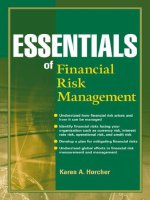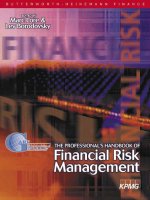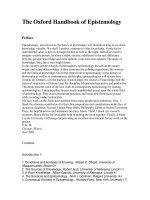the professional handbook of financial risk management (kpmg)
Bạn đang xem bản rút gọn của tài liệu. Xem và tải ngay bản đầy đủ của tài liệu tại đây (7.21 MB, 824 trang )
The Professional’s Handbook of
Financial Risk Management
The Professional’s Handbook of
Financial Risk Management
Edited by Marc Lore and Lev Borodovsky
Endorsed by the Global Association of Risk Professionals
OXFORD AUCKLAND BOSTON JOHANNESBURG MELBOURNE NEW DELHI
Butterworth-Heinemann
Linacre House, Jordan Hill, Oxford OX2 8DP
225 Wildwood Avenue, Woburn, MA 01801–2041
A division of Reed Educational and Professional Publishing Ltd
A member of the Reed Elsevier plc group
First published 2000
© Reed Educational and Professional Publishing Ltd 2000
All rights reserved. No part of this publication may be reproduced in
any material form (including photocopying or storing in any medium by
electronic means and whether or not transiently or incidentally to some
other use of this publication) without the written permission of the
copyright holder except in accordance with the provisions of the Copyright,
Designs and Patents Act 1988 or under the terms of a licence issued by the
Copyright Licensing Agency Ltd, 90 Tottenham Court Road, London,
England W1P 9HE. Applications for the copyright holder’s written
permission to reproduce any part of this publication should be
addressed to the publishers
British Library Cataloguing in Publication Data
The professional’s handbook of financial risk management
1 Risk management 2 Investments – Management
I Lore, Marc II Borodovsky, Lev
332.6
Library of Congress Cataloguing in Publication Data
The professional’s handbook of financial risk management/edited by Marc Lore and
Lev Borodovsky.
p.cm.
Includes bibliographical references and index.
ISBN 0 7506 4111 8
1 Risk management 2 Finance I Lore, Marc II Borodovsky, Lev.
HD61 1.P76
658.15@5—dc21 99–088517
ISBN 0 7506 4111 8
Typeset by AccComputing, Castle Cary, Somerset
Printed and bound in Great Britain
Contents
FOREWORD xi
PREFACE xiii
ABOUT GARP xiv
LIST OF CONTRIBUTORS xv
ACKNOWLEDGEMENTS xviii
INTRODUCTION xix
PART 1 FOUNDATION OF RISK MANAGEMENT
1. DERIVATIVES BASICS Allan M. Malz 3
Introduction 3
Behavior of asset prices 4
Forwards, futures and swaps 7
Forward interest rates and swaps 14
Option basics 16
Option markets 21
Option valuation 24
Option risk management 29
The volatility smile 34
Over-the-counter option market conventions 37
2. MEASURING VOLATILITY Kostas Giannopoulos 42
Introduction 42
Overview of historical volatility methods 42
Assumptions 43
Conditional volatility models 45
ARCH models: a review 46
Using GARCH to measure correlation 50
Asymmetric ARCH models 52
Identification and diagnostic tests for ARCH 53
An application of ARCH models to risk management 55
Conclusions 67
3. THE YIELD CURVE P. K. Satish 75
Introduction 75
Bootstrapping swap curve 77
Government Bond Curve 100
Model review 106
Summary 108
vi The Professional’s Handbook of Financial Risk Management
4. CHOOSING APPROPRIATE VaR MODEL PARAMETERS AND RISK
MEASUREMENT METHODS Ian Hawkins 111
Choosing appropriate VaR model parameters 112
Applicability of VaR 114
Uses of VaR 115
Risk measurement methods 115
Sources of market risk 117
Portfolio response to market changes 124
Market parameter estimation 128
Choice of distribution 128
Volatility and correlation estimation 130
Beta estimation 133
Yield curve estimation 134
Risk-aggregation methods 134
Covariance approach 138
Historical simulation VaR 144
Monte Carlo simulation VaR 145
Current practice 146
Specific risk 147
Concentration risk 148
Conclusion 148
PART 2 MARKET RISK, CREDIT RISK AND OPERATIONAL RISK
5. YIELD CURVE RISK FACTORS: DOMESTIC AND GLOBAL
CONTEXTS Wesley Phoa 155
Introduction: handling multiple risk factors 155
Principal component analysis 158
International bonds 168
Practical implications 174
6. IMPLEMENTATION OF A VALUE-AT-RISK SYSTEM Alvin Kuruc 185
Introduction 185
Overview of VaR methodologies 185
Variance/covariance methodology for VaR 187
Asset-flow mapping 191
Mapping derivatives 194
Gathering portfolio information from source systems 196
Translation tables 199
Design strategy summary 200
Covariance data 200
Heterogeneous unwinding periods and liquidity risk 201
Change of base currency 201
Information access 202
Portfolio selection and reporting 203
Contents vii
7. ADDITIONAL RISKS IN FIXED-INCOME MARKETS Teri L. Geske 215
Introduction 215
Spread duration 216
Prepayment uncertainty 223
Summary 231
8. STRESS TESTING Philip Best 233
Does VaR measure risk? 233
Extreme value theory – an introduction 237
Scenario analysis 239
Stressing VaR – covariance and Monte Carlo simulation methods 242
The problem with scenario analysis 244
Systematic testing 244
Credit risk stress testing 247
Determining risk appetite and stress test limits 251
Conclusion 254
9. BACKTESTING Mark Deans 261
Introduction 261
Comparing risk measurements and P&L 263
Profit and loss calculation for backtesting 265
Regulatory requirements 269
Benefits of backtesting beyond regulatory compliance 271
Systems requirements 282
Review of backtesting results in annual reports 285
Conclusion 286
10. CREDIT RISK MANAGEMENT MODELS Richard K. Skora 290
Introduction 290
Motivation 290
Functionality of a good credit risk management model 291
Review of Markowitz’s portfolio selection theory 293
Adapting portfolio selection theory to credit risk management 294
A framework for credit risk management models 295
Value-at-Risk 296
Credit risk pricing model 299
Market risk pricing model 301
Exposure model 301
Risk calculation engine 302
Capital and regulation 302
Conclusion 304
11. RISK MANAGEMENT OF CREDIT DERIVATIVES Kurt S. Wilhelm 307
Introduction 307
Size of the credit derivatives market and impediments to growth 308
What are credit derivatives? 312
Risks of credit derivatives 318
Regulatory capital issues 330
viii The Professional’s Handbook of Financial Risk Management
A portfolio approach to credit risk management 333
Overreliance on statistical models 338
Future of credit risk management 339
12. OPERATIONAL RISK Michel Crouhy, Dan Galai and Bob Mark 342
Introduction 342
Typology of operational risks 344
Who manages operational risk? 346
The key to implementing bank-wide operational risk management 348
A four-step measurement process for operational risk 351
Capital attribution for operational risks 360
Self-assessment versus risk management assessment 363
Integrated operational risk 364
Conclusions 365
13. OPERATIONAL RISK Duncan Wilson 377
Introduction 377
Why invest in operational risk management? 377
Defining operational risk 378
Measuring operational risk 386
Technology risk 396
Best practice 399
Regulatory guidance 403
Operational risk systems/solutions 404
Conclusion 412
PART 3 ADDITIONAL RISK TYPES
14. COPING WITH MODEL RISK Franc
¸
ois-Serge Lhabitant 415
Introduction 415
Model risk: towards a definition 416
How do we create model risk? 417
Consequences of model risk 426
Model risk management 431
Conclusions 436
15. LIQUIDITY RISK Robert E. Fiedler 441
Notation 441
First approach 442
Re-approaching the problem 449
Probabilistic measurement of liquidity – Concepts 451
Probabilistic measurement of liquidity – Methods 455
Dynamic modeling of liquidity 464
Liquidity portfolios 468
Term structure of liquidity 469
Transfer pricing of liquidity 471
Contents ix
16. ACCOUNTING RISK Richard Sage 473
Definition 473
Accounting for market-makers 474
Accounting for end-users 486
Conclusion 490
17. EXTERNAL REPORTING: COMPLIANCE AND DOCUMENTATION RISK
Thomas Donahoe 491
Introduction 491
Defining compliance risk 492
Structuring a compliance unit 493
Creating enforceable policies 499
Implementing compliance policies 508
Reporting and documentation controls 513
Summary 520
18. ENERGY RISK MANAGEMENT Grant Thain 524
Introduction 524
Background 524
Development of alternative approaches to risk in the energy markets 525
The energy forward curve 526
Estimating market risk 536
Volatility models and model risk 542
Correlations 543
Energy options –financial and ‘real’ options 543
Model risk 545
Value-at-Risk for energy 546
Stress testing 547
Pricing issues 548
Credit risk – why 3000% plus volatility matters 548
Operational risk 551
Summary 555
19. IMPLEMENTATION OF PRICE TESTING Andrew Fishman 557
Overview 557
Objectives and defining the control framework 559
Implementing the strategy 563
Managing the price testing process 573
Reporting 574
Conclusion 578
PART 4 CAPITAL MANAGEMENT, TECHNOLOGY AND REGULATION
20. IMPLEMENTING A FIRM-WIDE RISK MANAGEMENT FRAMEWORK
Shyam Venkat 581
Introduction 581
Understanding the risk management landscape 583
Establishing the scope for firm-wide risk management 585
Defining a firm-wide risk management framework 587
Conclusion 612
x The Professional’s Handbook of Financial Risk Management
21. SELECTING AND IMPLEMENTING ENTERPRISE RISK MANAGEMENT
TECHNOLOGIES Deborah L. Williams 614
Introduction: enterprise risk management, a system implementation
like no other 614
The challenges 615
The solution components 618
Enterprise risk technology market segments 623
Different sources for different pieces: whom to ask for what? 627
The selection process 629
Key issues in launching a successful implementation 631
Conclusions 633
22. ESTABLISHING A CAPITAL-BASED LIMIT STRUCTURE
Michael Hanrahan 635
Introduction 635
Purpose of limits 635
Economic capital 637
Types of limit 644
Monitoring of capital-based limits 654
Summary 655
23. A FRAMEWORK FOR ATTRIBUTING ECONOMIC CAPITAL AND
ENHANCING SHAREHOLDER VALUE Michael Haubenstock and
Frank Morisano 657
Introduction 657
Capital-at-risk or economic capital 658
A methodology for computing economic capital 659
Applications of an economic capital framework 675
Applying economic capital methodologies to improve shareholder
value 680
Conclusion 687
24. INTERNATIONAL REGULATORY REQUIREMENTS FOR RISK
MANAGEMENT (1988–1998) Mattia L. Rattaggi 690
Introduction 690
Quantitative capital adequacy rules for banks 691
Risk management organization of financial intermediaries and
disclosure recommendations 716
Cross-border and conglomerates supervision 723
Conclusion 726
25. RISK TRANSPARENCY Alan Laubsch 740
Introduction 740
Risk reporting 740
External risk disclosures 764
INDEX 777
Foreword
The role and importance of the risk management process (and by definition the
professional risk manager) has evolved dramatically over the past several years. Until
recently risk management was actually either only risk reporting or primarily a
reactive function. The limited risk management tasks and technology support that
did exist were usually assigned to ex-traders or product controllers with little or no
support from the rest of business. The term professional risk manager was virtually
unheard of in all but the largest and most sophisticated organizations. Only after a
series of well-publicised losses and the accompanying failure of the firms involved did
the need for sophisticated, proactive and comprehensive financial risk management
processes become widely accepted.
The new world of the professional risk manager is one that begins in the boardroom
rather than the back office. The risk management process and professionals are now
recognized as not only protecting the organization against unexpected losses, but
also fundamental to the efficient allocation of capital to optimize the returns on risk.
The professional risk manager, when properly supported and utilized, truly provides
added value to the organization.
A number of risk books were published in the latter half of the 1990s. They
addressed the history of risk, how it evolved, the psychological factors that caused
individuals to be good or bad risk takers and a myriad of other topics. Unfortunately,
few books were written on the proper management of the growing population and
complexity of risks confronting institutions. Marc Lore, Lev Borodovsky and their
colleagues in the Global Association of Risk Professionals recognized this void and
this book is their first attempt to fill in some of the blank spaces.
KPMG is pleased to the be the primary sponsor of GARP’s The Professional’s
Handbook of Financial Risk Management. We believe that this volume offers the
reader practical, real world insights into leading edge practices for the management
of financial risk regardless of the size and sophistication of their own organization.
For those contemplating a career in risk management, the authors of this text are
practising financial risk managers who provide knowledgeable insights concerning
their rapidly maturing profession.
No one volume can ever hope to be the ultimate last word on a topic that is evolving
as rapidly as the field of financial risk management. However, we expect that this
collection of articles, written by leading industry professionals who understand the
risk management process, will become the industry standard reference text. We hope
that after reviewing their work you will agree.
Martin E. Titus, Jr
Chairman, KPMG GlobeRisk
Preface
Risk management encompasses a broad array of concepts and techniques, some of
which may be quantified, while others must be treated in a more subjective manner.
The financial fiascos of recent years have made it clear that a successful risk manager
must respect both the intuitive and technical aspects (the ‘art’ and the ‘science’)of
the discipline. But no matter what types of methods are used, the key to risk
management is delivering the risk information in a timely and succinct fashion, while
ensuring that key decision makers have the time, the tools, and the incentive to act
upon it. Too often the key decision makers receive information that is either too
complex to understand or too large to process. In fact, Gerald Corrigan, former
President of the New York Federal Reserve, described risk management as ‘getting
the right information to the right people at the right time’.
History has taught us time and time again that senior decision makers become so
overwhelmed with VaR reports, complex models, and unnecessary formalism that
they fail to account for the most fundamental of risks. An integral part of the risk
manager’s job therefore is to present risk information to the decision maker in a
format which not only highlights the main points but also directs the decision maker
to the most appropriate course of action. A number of financial debacles in 1998,
such as LTCM, are quite representative of this problem. Risk managers must work
proactively to discover new ways of looking at risk and embrace a ‘common sense’
approach to delivering this information.
As a profession, risk management needs to evolve beyond its traditional role of
calculating and assessing risk to actually making effective use of the results. This
entails the risk manager examining and presenting results from the perspective of
the decision maker, bearing in mind the knowledge base of the decision maker. It
will be essential over the next few years for the risk manager’s focus to shift from
calculation to presentation and delivery.
However, presenting the right information to the right people is not enough. The
information must also be timely. The deadliest type of risk is that which we don’t
recognize in time. Correlations that appear stable break down, and a VaR model that
explains earnings volatility for years can suddenly go awry. It is an overwhelming
and counterproductive task for risk managers to attempt to foresee all the potential
risks that an organization will be exposed to before they arise. The key is to be able
to separate those risks that may hurt an institution from those that may destroy it,
and deliver that information before it is too late.
In summary, in order for risk management to truly add value to an organization,
the risk information must be utilized in such a way as to influence or alter the
business decision-making process. This can only be accomplished if the appropriate
information is presented in a concise and well-defined manner to the key decision
makers of the firm on a timely basis.
Editors: Marc Lore and Lev Borodovsky
Co-ordinating Editor: Nawal K. Roy
Assistant Editors: Lakshman Chandra and Michael Hanrahan
About GARP
The Global Association of Risk Professionals (GARP) is a not-for-profit, independent
organization of over 10 000 financial risk management practitioners and researchers
from over 90 countries. GARP was founded by Marc Lore and Lev Borodovsky in
1996. They felt that the financial risk management profession should extend beyond
the risk control departments of financial institutions. GARP is now a diverse interna-
tional association of professionals from a variety of backgrounds and organizations
who share a common interest in the field.
GARP’s mission is to serve its members by facilitating the exchange of information,
developing educational programs, and promoting standards in the area of financial
risk management. GARP members discuss risk management techniques and stan-
dards, critique current practices and regulation, and help bring forth potential risks
in the financial markets to the attention of other members and the public. GARP
seeks to provide open forums for discussion and access to information such as
events, publications, consulting and software services, jobs, Internet sites, etc. To
join GARP visit the web site at www.garp.com
Contributors
EDITORS
Ω Marc Lore
Executive Vice President and Head of Firm-Wide Risk Management and Control,
Sanwa Bank International, City Place House, PO Box 245, 55 Basinghall St,
London EC2V 5DJ, UK
Ω Lev Borodovsky
Director, Risk Measurement and Management Dept, Credit Suisse First Boston,
11 Madison Avenue, New York, NY 10010-3629, USA
Co-ordinating Editor
Ω Nawal K. Roy
Associate Vice President, Credit Suisse First Boston, 11 Madison Avenue, New
York, NY10010-3629, USA
Assistant Editors
Ω Lakshman Chandra
Business Manager, Risk Management Group, Sanwa Bank International, City Place
House, PO Box 245, 55 Basinghall St, London EC2V 5DJ, UK
Ω Michael Hanrahan
Assistant Vice President, Head of Risk Policy, Sanwa Bank International, City Place
House, PO Box 245, 55 Basinghall St, London EC2V 5DJ, UK
CONTRIBUTORS
Ω Philip Best
Risk specialist, The Capital Markets Company, Clements House, 14–18 Gresham
St, London, EC2V 7JE, UK
Ω Michel Crouhy
Senior Vice President, Market Risk Management, Canadian Imperial Bank of
Commerce, 161 Bay Street, Toronto, Ontario M5J 2S8, Canada
Ω Mark Deans
Head of Risk Management and Regulation, Sanwa Bank International, 55 Basinghall
Street, London, EC2V 5DJ, UK
Ω Thomas Donahoe
Director, MetLife, 334 Madison Avenue, Area 2, Convent Station, NJ 07961, USA
Ω Robert E. Fiedler
Head of Treasury and Liquidity Risk, Methodology and Policy Group Market Risk
Management, Deutsche Bank AG, D-60262 Frankfurt, Germany
Ω Andrew Fishman
Principal Consultant, The Capital Markets Company, Clements House,
14–18 Gresham St, London, EC2V 7JE, UK
xvi The Professional’s Handbook of Financial Risk Management
Ω Dan Galai
Abe Gray Professor, Finance and Administration, Hebrew University, School of
Business Administration in Jerusalem, Israel
Ω Teri L. Geske
Senior Vice President, Product Development, Capital Management Sciences,
11766 Wilshire Blvd, Suite 300, Los Angeles, CA 90025, USA
Ω Kostas Giannopoulos
Senior Lecturer in Finance, Westminster Business School, University of
Westminster, 309 Regent St, London W1R 8AL, UK
Ω Michael Haubenstock
PricewaterhouseCoopers LLP, 1177 Avenue of the Americas, New York, NY 10036, USA
Ω Ian Hawkins
Assistant Director, Global Derivatives and Fixed Income, Westdeutsche
Landesbank Girozentrale, 1211 Avenue of the Americas, New York, NY 10036, USA
Ω Alvin Kuruc
Senior Vice President, Infinity, a SunGard Company, 640 Clyde Court, Mountain
View, CA 04043, USA
Ω Alan Laubsch
Partner, RiskMetrics Group, 44 Wall Street, New York, NY 10005, USA
Ω Franc
¸
ois-Serge Lhabitant
Director, UBS Ag, Aeschenplatz 6, 4002 Basel, Switzerland, and Assistant Professor
of Finance, Thunderbird, the American Graduate School of International
Management, Glendale, USA
Ω Allan M. Malz
Partner, RiskMetrics Group, 44 Wall St, NY 10005, USA
Ω Bob Mark
Executive Vice President, Canadian Imperial Bank of Commerce, 161 Bay Street,
Toronto, Ontario, M5J 2S8, Canada
Ω Frank Morisano
Director, PricewaterhouseCoopers LLP, 1177 Avenue of the Americas, New York,
NY 10036, USA
Ω Wesley Phoa
Associate, Quantitative Research, Capital Strategy Research, 11100 Santa Monica
Boulevard, Los Angeles, CA 90025, USA
Ω Mattia L. Rattaggi
Corporate Risk Control, UBS, AG, Pelikanstrasse 6, PO Box 8090, Zurich,
Switzerland
Ω Richard Sage, FRM
Director, Enron Europe, Flat 1, 25 Bedford Street, London WC2E 9EQ
Ω P. K. Satish, CFA
Managing Director, Head of Financial Engineering and Research, Askari Risk
Management Solutions, State St Bank & Trust Company, 100 Avenue of the
Americas, 5th Floor, New York, NY 10013, USA
Ω Richard K. Skora
President, Skora & Company Inc., 26 Broadway, Suite 400, New York, NY 10004,
USA
Ω Grant Thain
Senior Vice President, Risk Management, Citizens Power LLC, 160 Federal Street,
Boston, MA 02110, USA
Contributors xvii
Ω Shyam Venkat
Partner, PricewaterhouseCoopers LLP, 1177 Avenue of the Americas, New York,
NY 10036, USA
Ω Kurt S. Wilhelm, FRM, CFA
National Bank Examiner, Comptroller of the Currency, 250 E St SW, Washington,
DC 20219, USA
Ω Deborah L. Williams
Co-founder and Research Director, Meridien Research, 2020 Commonwealth
Avenue, Newton, MA 02466, USA
Ω Duncan Wilson
Partner, Global Risk Management Practice, Ernst & Young, Rolls House, 7 Rolls
Building, Fetter Lane, London EC4A 1NH, UK
Acknowledgements
We would like to thank our wives Carolyn and Lisa for all their tremendous help,
support, and patience. We also wish to thank all the authors who have contributed
to this book. Special thanks go to Nawal Roy for his superb effort in pulling this
project together and always keeping it on track, as well as his remarkable assistance
with the editing process. We wish to thank Michael Hanrahan and Lakshman
Chandra for writing the Introduction and their help in editing. Finally we would like
to thank all GARP’s members for their continued support.
Marc Lore
Lev Borodovsky
Introduction
The purpose of this book is to provide risk professionals with the latest standards
that represent best practice in the risk industry. The book has been created with the
risk practitioner in mind. While no undertaking of this size can be devoid of theory,
especially considering the ongoing changes and advances within the profession itself,
the heart of this book is aimed at providing practising risk managers with usable
and sensible information that will assist them in their day-to-day work.
The successful growth of GARP, the Global Association of Risk Professionals, has
brought together thousands of risk professionals and has enabled the sharing of
ideas and knowledge throughout the risk community. The existence of this forum
has also made apparent that despite the growing size and importance of risk
management in the financial world, there is no book in the marketplace that covers
the wide array of topics that a risk manager can encounter on a daily basis in a
manner that suits the practitioner. Rather, the practitioner is besieged by books that
are theoretical in nature. While such books contain valuable insights that are critical
to the advancement of our profession, most risk professionals are never able to utilize
and test the concepts within them.
Consequently, a familiar theme has emerged at various GARP meetings and
conferences that a risk handbook needs to be created to provide risk practitioners
with knowledge of the practices that other risk professionals have employed at
their own jobs. This is especially important considering the evolving nature of
risk management that can be characterized by the continuous refinement and
improvement of risk management techniques, which have been driven by the increas-
ingly complex financial environment.
One of the challenges of this book has been to design its contents so that it can
cover the vast area that a risk manager encounters in his or her job and at the same
time be an aid to both the experienced and the more novice risk professional.
Obviously, this is no easy task. While great care has been taken to include material
on as many topics that a risk manager might, and even should, encounter at his or
her job, it is impossible to provide answers to every single question that one might
have. This is especially difficult considering the very nature of the risk management
profession, as there are very few single answers that can automatically be applied to
problems with any certainty. The risk management function in an organization
should be a fully integrated one. While it is independent in its authority from other
areas within the bank, it is at the same time dependent on them in that it receives
and synthesizes information, information which is critical to its own operations, from
these other areas.
Consequently, the decisions made by risk managers can impact on the entire firm.
The risk manager, therefore, must tailor solutions that are appropriate considering
the circumstances of the institution in which he or she is working, the impact that
the solution might have on other areas of the organization, and the practical
considerations associated with implementation that must be factored into any chosen
decision.
xx The Professional’s Handbook of Financial Risk Management
This handbook has thus been designed to delve into the various roles of the risk
management function. Rather than describing every possible role in exhaustive
detail, the authors have attempted to provide a story line for each of the discussed
topics, including practical issues that a risk manager needs to consider when tackling
the subject, possible solutions to difficulties that might be encountered, background
knowledge that is essential to know, and more intricate practices and techniques
that are being used. By providing these fundamentals, the novice risk professional
can gain a thorough understanding of the topic in question while the more experi-
enced professional can use some of the more advanced concepts within the book.
Thus the book can be used to broaden one’s own knowledge of the risk world, both
by familiarizing oneself with areas in which the risk manager lacks experience and
by enhancing one’s knowledge in areas in which one already has expertise.
When starting this project we thought long and hard as to how we could condense
the myriad ideas and topics which risk management has come to represent. We
realized early on that the growth in risk management ideas and techniques over the
last few years meant that we could not possibly explain them all in detail in one
book. However, we have attempted to outline all the main areas of risk management
to the point where a risk manager can have a clear idea of the concepts being
explained. It is hoped that these will fire the thought processes to the point where a
competent risk manager could tailor the ideas to arrive at an effective solution for
their own particular problem.
One of the obstacles we faced in bringing this book together was to decide on the
level of detail for each chapter. This included the decision as to whether or not each
chapter should include practical examples of the ideas being described and what it
would take practically to implement the ideas. It was felt, however, that the essence
of the book would be best served by not restricting the authors to a set format for
their particular chapter. The range of topics is so diverse that it would not be practical
in many cases to stick to a required format. It was also felt that the character of the
book would benefit from a ‘free form’ style, which essentially meant giving the authors
a topic and letting them loose. This also makes the book more interesting from the
reader’s perspective and allowed the authors to write in a style with which they were
comfortable.
Therefore as well as a book that is diverse in the range of topics covered we have
one with a range of perspectives towards the topics being covered. This is a facet that
we think will distinguish this book from other broad-ranging risk management books.
Each author has taken a different view of how his or her topic should be covered.
This in turn allows us to get a feel for the many ways in which we can approach a
problem in the risk management realm. Some authors have taken a high-level
approach, which may befit some topics, while others have gone into the detail.
In addition, there are a number of chapters that outline approaches we should take
to any risk management problem. For example, Deborah Williams’ excellent chapter on
enterprise risk management technologies gives us a good grounding on the approach
to take in implementing a systems-based solution to a risk management problem.
As well as providing practical solutions this book also covers many topics which
practitioners in the financial sector would not necessarily ever encounter. We are
sure that readers will find these insights into areas outside their normal everyday
environments to be both interesting and informative. For any practitioners who think
the subtleties of interest rate risk are complicated, we would recommend a read of
Grant Thain’s chapter on energy risk management!
Introduction xxi
As mentioned earlier, we could not hope to impose limits on the authors of this
book while allowing them free reign to explore their particular topic. For this reason
we feel that a glossary of terms for this book would not necessarily be useful. Different
authors may interpret the same term in many different ways, and therefore we would
ask that the reader be careful to understand the context in which a particular phrase
is being used. All authors have been quite clear in defining ambiguous words or
phrases, whether formally or within the body of the text, so the reader should not
have too much difficulty in understanding the scope in which phrases are being
used.
Rather than one writer compiling the works of various authors or research papers
it was felt that the best approach to producing a practical risk management guide
was to let the practitioners write it themselves. Using the extensive base of contacts
that was available from the GARP membership, leaders in each field were asked to
produce a chapter encapsulating their knowledge and giving it a practical edge.
Condensing their vast knowledge into one chapter was by no means an easy feat
when we consider that all our contributors could quite easily produce a whole book
on their specialist subject. Naturally The Professional’s Handbook of Financial Risk
Management would not have come about without their efforts and a willingness or
even eagerness to share their ideas and concepts.
It should be noted that every effort was made to select people from across the risk
management spectrum, from insurance and banking to the regulatory bodies and
also the corporations and utility firms who are the main end-users of financial
products. Each sector has its own view on risk management and this diverse outlook
is well represented throughout the book.
All authors are leaders in their field who between them have the experience and
knowledge, both practical and theoretical, to produce the definitive risk management
guide. When asking the contributors to partake in this project we were quite over-
whelmed by the enthusiasm with which they took up the cause. It is essential for
those of us in the risk management arena to share knowledge and disseminate what
we know in order to assist each other in our one common aim of mitigating risk. This
book demonstrates how the risk management profession has come of age in realizing
that we have to help each other to do our jobs effectively. This is best illustrated by
the manner in which all our authors contrived to ensure we understand their subject
matter, thus guaranteeing that we can use their solutions to our problems.
Editorial team
Part 1
Foundation of risk
management
1
Derivatives basics
ALLAN M. MALZ
Introduction
Derivative assets are assets whose values are determined by the value of some other
asset, called the underlying. There are two common types of derivative contracts,
those patterned on forwards and on options. Derivatives based on forwards have
linear payoffs, meaning their payoffs move one-for-one with changes in the under-
lying price. Such contracts are generally relatively easy to understand, value, and
manage. Derivatives based on options have non-linear payoffs, meaning their payoffs
may move proportionally more or less than the underlying price. Such contracts can
be quite difficult to understand, value, and manage.
The goal of this chapter is to describe the main types of derivatives currently in
use, and to provide some understanding of the standard models used to value these
instruments and manage their risks. There is a vast and growing variety of derivative
products – among recent innovations are credit and energy-related derivatives. We
will focus on the most widely used instruments and on some basic analytical concepts
which we hope will improve readers’ understanding of any derivatives issues they
confront.
Because a model of derivative prices often starts out from a view of how the
underlying asset price moves over time, the chapter begins with an introduction to
the ‘standard view’ of asset price behavior, and a survey of how asset prices actually
behave. An understanding of these issues will be helpful later in the chapter, when
we discuss the limitations of some of the benchmark models employed in derivatives
pricing.
The chapter then proceeds to a description of forwards, futures and options. The
following sections provide an introduction to the Black–Scholes model. Rather than
focusing primarily on the theory underlying the model, we focus on the option market
conventions the model has fostered, particularly the use of implied volatility as a
metric for option pricing and the use of the so-called ‘greeks’ as the key concepts in
option risk management.
In recent years, much attention has focused on differences between the predictions
of benchmark option pricing models and the actual patterns of option prices, particu-
larly the volatility smile, and we describe these anomalies. This chapter concludes
with a sections discussing certain option combinations, risk reversals and strangles,
by means of which the market ‘trades’ the smile.









